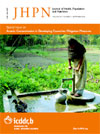
|
The Journal of Health, Population and Nutrition
icddr,b
ISSN: 1606-0997
EISSN: 1606-0997
Vol. 28, No. 4, 2010, pp. 369-374
|
 Bioline Code: hn10048
Bioline Code: hn10048
Full paper language: English
Document type: Research Article
Document available free of charge
|
|
|
The Journal of Health, Population and Nutrition, Vol. 28, No. 4, 2010, pp. 369-374
| en |
Limited access to iodized salt among the poor and disadvantaged in north 24 parganas District of West Bengal, India
Sen, Tapas Kumar; Das, Dilip Kumar; Biswas, Akhil Bandhu; Chakrabarty, Indranil; Mukhopadhyay, Sujishnu & Roy, Rabindranath
Abstract
Iodine deficiency is endemic in West Bengal as evident from earlier studies. This community-based, cross-sectional descriptive study was conducted in North 24 Parganas district during August-November 2005 to assess the consumption of adequately-iodized salt and to ascertain the various factors that influence access to iodized salt. In total, 506 households selected using the multi-stage cluster-sampling technique and all 79 retail shops from where the study households buy salt were surveyed. The iodine content of salt was tested by spot iodine-testing kits. Seventy-three percent of the households consumed salt with adequate iodine content (≥15 ppm). Consumption of adequately-iodized salt was lower among rural residents [prevalence ratio (PR): 0.8, 95% confidence interval (CI) 0.7-0.9], Muslims (PR: 0.8, 95% CI 0.7-0.9), and households with monthly per-capita income of ≤US$ 10 (PR: 0.7, 95% CI 0.6-0.8). Those who heard and were aware of the risk of iodine-deficiency disorders and of the benefit of iodized salt were more likely to use appropriate salt (PR: 1.2, 95% CI 1.1-1.3). Those who were aware of the ban on non-iodized salt were more likely to consume adequately-iodized salt (PR: 1.1, 95% CI 1.01-1.3). The iodine content was higher in salt sold in sealed packets (PR: 2.9, 95% CI 1.8-4.8) and stored on shelves (PR: 1.6, 95% CI 1.3-2.0). Seventy-two percent of the salt samples from the retail shops had the iodine content of ≥15 ppm. The findings indicate that elimination of iodine deficiency will require targeting the vulnerable and poor population.
Keywords
Community-based studies; Cross-sectional studies; Descriptive studies; Goitre; Iodine; Iodine deficiency; Iodized salt; Socioeconomic factors; India
|
| |
© Copyright 2010 Journal of Health Population and Nutrition.
Alternative site location: http://www.jhpn.net
|
|
